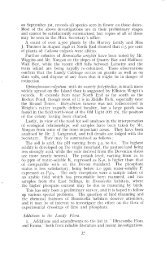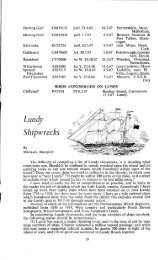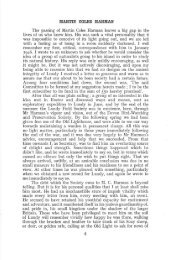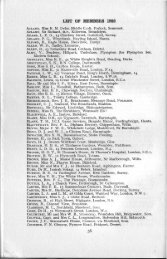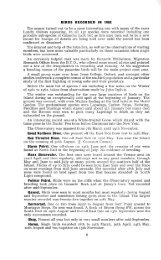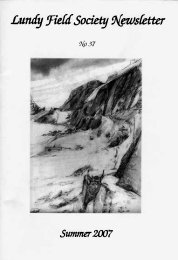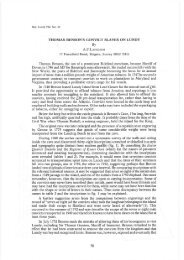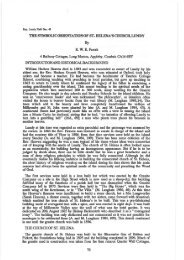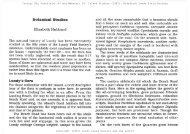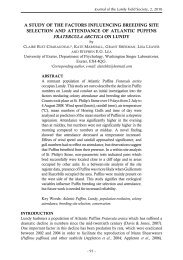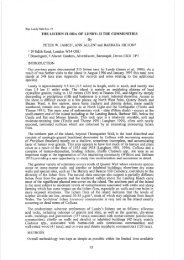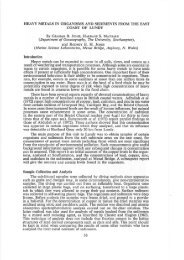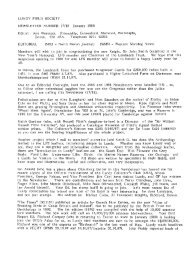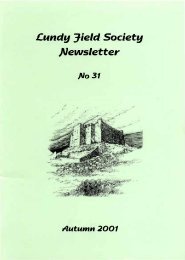THE MORPHOLOGY OF LIMPET SPECIES ON THE ... - Lundy
THE MORPHOLOGY OF LIMPET SPECIES ON THE ... - Lundy
THE MORPHOLOGY OF LIMPET SPECIES ON THE ... - Lundy
Create successful ePaper yourself
Turn your PDF publications into a flip-book with our unique Google optimized e-Paper software.
Rep. <strong>Lundy</strong> Field Soc. 48<strong>THE</strong> <strong>MORPHOLOGY</strong> <strong>OF</strong> <strong>LIMPET</strong> <strong>SPECIES</strong> <strong>ON</strong> <strong>THE</strong>ROCKYSHORES<strong>OF</strong>LUNDYByLIZ EVANSDepartment of Environmental and Biological Studies, Liverpool Hope University College,Hope Park, Childwall, Liverpool, Ll6 910ABSTRACT<strong>Lundy</strong> has shores of every orientation making an ideal opportunity for research into the ecologyof the coastal zone. Here the results of a final year undergraduate research project aredescribed. The dimensions of limpets were measured on six shores around <strong>Lundy</strong> and the relationshipbetween shell length and height established. The results show that there is a differencein size between limpets present on the upper and lower shore, with larger limpets generallyfound on the upper shore. Also, shell shape can be correlated to shores of differing wave exposurewith more exposed shores possessing smaller and more conical individuals than thosefound on sheltered shores.INTRODUCTI<strong>ON</strong>The shores of <strong>Lundy</strong> are exposed to a range of strengths and frequencies of wave action. Thisrange of wave exposure provides the opportunity to study the morphology of limpets (Patellaspp.) in relation to the severity and frequency of wave action. There are a number of viewsconcerning the morphology of limpet species and the environmental factors that influencethem (Beaumont and Wei 1991; Branch and Marsh 1978; Davies 1969). One belief is that shellshape may be influenced by wave exposure, which apart from size, type and frequency ofwaves approaching the shore, is determined by environmental conditions such as topography,orientation and gradient of shore (Brehaut 1982). Generally, if the shore is extensive, flattenedand irregular, the wave conditions will be gentle, but if the shore is steep and has no shelter,wave action will be violent. Brehaut (1982) states that on wave exposed shores the repeatedmuscular contraction of ti1e foot, required to maintain the position of the limpet, results in themantle being drawn inwards. This in turn results in the shell becoming tall and narrow, or moreconical. Conversely, on a less exposed, or sheltered shore it would be expected that limpetswould be more flattenedThis paper reports the findings of a final year undergraduate research project. The aimsof this study were to investigate the effects of exposure on the morphological adaptations oflimpets and to ascertain whether a relationship exists between shell shape and degree of shoreexposure to wave action.METHODSix sites were chosen as a means of assessing the effects of different wave exposures on themorphology of Patella spp. (Table I). The shores were graded subjectively according toaspect, wave action and extensiveness, and assigned a rating between I and 5. The exposure67
Figure I. Represerrtative cross section through Patella spp. to show the mean length andheight for the upper and lower shores for each site. The apex is taken to be central to thelimpet shell, which is not entirely accurate but allows for easier comparison.Jem1y' 5 Cove:Lowe.r ShoreUpper ShorePuffin Gully:Lower ShoreUpper ShoreDevil'!i Kitchen:Lower ShoreUpper ShoreQuarry Bay:Lower ShoreUpper ShoreTbree Quarter WaH Ba:':Lower Short:Upper ShoreThe Landing Bay:Low~r ShoreUpper Shore~calc (em)68
atings for Quarry Bay, The Landing Bay and Jenny's Cove correspond to ratings previouslyallocated by Hawkins and Hiscock (1983).Although there are three species of Patella (P vulgata, P ulyssiponensis [otherwisereferred to asP aspera] and P depressa) found on the rocky shores of the British Isles, individualswere not identified to the species level in this study. This is due to the destructivenature of identification combined with respect for <strong>Lundy</strong> as a Marine Nature Reserve.The sample of limpets was chosen using random number tables to determine the startingpoint of an interrupted belt transect from the upper limit of their distribution to as close to sealevel as the author could reach during low tide. The same technique was used to select the subsequentpositions of quadrats along the transects. Within each I m sq. quadrat one limpet waschosen arbitrarily. From this limpet four further individuals were selected at varying distances,again determined by random number tables. Limpets were measured in situ. The greatestlength and the greatest width of the shell were measured using calipers. Height of the shell.was measured using a sliding rule.The sample number of limpets varied between sites, owing to time constraints caused bytidal influences at some shores. Study was also restricted to a two week period, which prohibitedextensive collection of data. The raw data was then subject to statistical analysis (usingAnalysis of Variance, t-tests and linear regressions) to establish whether there was a relationshipbetween exposure of a shore and Patella morphology. Statistics account for unequal samplesizes.RESULTSThe length, width and height of limpets (Tables 2a & 2b; Fig. I) varied between shores andwithin a single shore. Statistical analysis supports these results by indicating where significantdifferences lie.Analysis of Variance shows a highly significant (p
DISCUSSI<strong>ON</strong>The Analysis of Variance clearly &hows that the upper shores of the different sites possessPatella individuals of very different dimensions. Significant differences were also shownbetween the lower shores for each dimension, although the fact that the lower station dependedon tidal height makes samples not strictly comparable. It w·as found that on the exposedshores of the west coast (Devil's Kitchen, Puffin Gully and Jenny's Cove) Patella individualswere far smaller in size than those found on the sheltered shores of the east coast.Furthermore, the Patella individuals on the Landing Bay shore were also significantly smallerthan those on the other two east coast shores (Three Quarter Wall Bay and Quarry Bay).The Landing Bay is a very sheltered shore and its similarity with the truly wave exposedshores negates a relationship between shell size and exposure to wave action. It is possible tospeculate that on an exposed shore, only Patella individuals that have small shell dimensionsare capable of survival; however, there is no such explanation for the small shell dimensionsof The Landing Bay.Within a single shore it has been observed that significant differences in size occurbetween Patella individuals on the upper compared with the lower shore. At the upper shore,for each dimension, limpets are larger (with the exception of the Landing Bay). However,Three Quarter Wall Bay and Quarry Bay had significant differences for height only, indicatingthat at the upper shore organisms are more conical. Devil's Kitchen, Puffin Gully andJenny's Cove all had significantly different sizes of limpets at the upper and lo wer ranges foreach dimension.The difference between she ll shape on the upper and lower parts of the shores is mostlikely due to different periods of emersion. The upper part of the shore could therefore be consideredas having harsher conditions leading to greater problems of desiccation, which hasalso been linked with shell shape of Patella spp. (Davies 1969). Other non-favourable conditions,for example chemical factors including lowered salinity during rainfall and oxygenavailability, may also require Patella spp. to adapt morphologically and behaviourally (Lewis1964). Lowell ( 1984) has proposed that predation may influence the shape of limpet shell s.The regression analysis used here gives an indication as to how the wave exposure of a shorecan also affect this, and it has been proposed (Brehaut, 1982) that the more exposed the shore,the greater the height of a limpet proportional to other measurements. Thus, the greater thegradient of the shell , the more conical the limpet.The regression analysis of limpets on <strong>Lundy</strong> showed some correspondence to Brehaut's( 1982) theory, particularly on the upper shores of each site where regressions can be rankedin order of limpet shape, from conical to flattened. The expect.ed relationship is clearly shown:that the more exposed a shore to wave action, the greater the steepness of the limpet shell.According to the gradients of the regression equations (shown in Table 3) the upper shoremorphologies are placed in the following order:ConicalRank according to Shell Morphology(steepness of the shell) ,Puffin Gull yJenny's CoveDevil's KitchenWave exposurerating45370
FlattenedThree Quarter Wall BayThe Landing BayQuarry Bay222The sequence of the upper shore populations corresponds well to the original grading ofthe shores according to wave exposure (Table I). The three wave exposed shores have a moreconical limpet shell shape, and the three sheltered shores possess more fl attened limpets.In conclusion, the results show a positive correlation between the conical ness of limpetsand exposure of a shore, but this could be due to species dominance. For example, QuarryBay possessed large limpets compared to those found at Devil's Kitchen. It is possible thaton Quarry Bay the dominant species is P. vulgata or P. ulyssiponensis, both of which growto up to 60 mm in length. However, P. depressa grows to only 30 mm in length (Fish andFish 1 9~9), which if predominant on Devil's Kitchen may lead to false conclusions aboutsize being related to wave exposure. Also, the sample size was quite small for a statisticallybased study, but unavoidabl e owing to time restrictions, and should be increased if this studyis repeated. The results are therefore indicative rather than definitive. Although the resultsappear to reflect conclusions from previous literature (Beaumont and Wei 1991 ; Brehaut1982) further research may provide a different explanation for the link between shell shapeof Patella spp. and shore exposure.REFERENCESBeaumont A. R. and Wei J. H. C., 1991 . Morphological and genetic variation in theAntarctic limpet Nacella concinna (Strebel 1908). Journal of Molluscan Studies 57,443-450.Branch G. M. and Marsh A. C., 1978. Tenacity and shell shape on six Patella species:adaptive features. Journal of Experimental Marine Biology and Ecology 34, 111 - 130.Brehaut R. N. , 1982. Ecology of rocky shores. London: Edward ArnoldDavies, P. S. (1966) Physiological ecology of Patella. I. The effect of body size and temperatureon metabolic rate. Journal of the Marine Biological Association of the UK 49,291 - 304.Fish J. D. and FishS., 1989. A students guide to the seashore. London: Unwin Hyman.Hawk ins S. J. and Hiscock K., 1983. Anomalies in the abundance of common eulittoralgastropods with planktonic larvae on <strong>Lundy</strong> Island, Bristol Channel. Joumal ofMolluscan Studies 49 , 86-88.Lew is J. R. , 1964. The ecology of rocky shores. English Universities Press Ltd.Lowell R B, 1984. Desiccation of intertidal limpets: effects of she ll size, fit to substratumand shape. Journal of Experimental Marine Biology and Ecology 77, 197- 207.71
Table I. The sites investigated. Each shore was allocated an exposure rating (given in thetable), on a subjective scale from I to 5 (very sheltered to very exposed), based on extensivenessof shore, wave action and topographic relief.Location Grid Description ExposureReferenceRatingJenny's Cove 132459 A steep shore on the west of the island, 5which is highly susceptible to the forceof Atlantic winds, and currents.Puffin Gully 134481 A steep shore on the north of the island. 4Devil 's Kitchen 148437 An extensive shore on the south coast with 3shallow incline. Sheltered by topographicrelief from the south west of the island.Quarry Bay 140448 An east facing shore with protection offered 2by the headlands enclosing the shore.Three Quarter Wall 139466 Another east facing shore, sheltered by the 2Bayrock protrusions enclosing the shore.The Landing Bay 145438 A north east facing shore with a high level 2of topographic relief.Table 2a. The mean measurements for each lower shore studied. Standard deviation from themean and the number of individuals measured are included.Site Height Variable Mean Standard Numberabove Chart (mm) Deviation Measureddatum (m)Length 29.76 6.809 25Jenny's Cove 2.3 Width 24 5.98 25Height 12.36 3.94 25Length 26.04 10.11 25Puffin Gully 0.5 Width 20.88 9.1 25Height 9.96 5.103 25Length 26.16 5.41 25Devil's Kitchen 2.1 Width 20.76 5.101 25Height 8 2.69 25Length 52.75 8.87 44Three Quarter 0.3 Width 46.8 9.0722 44Wall Bay Height 18 .5 5.394 44Length 49.76 7.096 25Quarry Bay 0.3 Width 42.08 6.422 25Height 20.68 4.12 2572
The Landing Bay 1.8LengthWidthHeight34.5228.5214.28.38 257.55 254.9125Table 2b. The mean measurements for each upper shore studied. Standard deviation fromthe mean and the number of individuals measured are included.Site Variable Mean Standard Number(mm) Deviation MeasuredLength 34.24 7.55 25Jenny's Cove Width 27.24 6.82 25Height 16.24 5.0 25Length 41.36 6.82 25Puffin Gully Width 35 .76 6.34 25Height 23.72 6.11 25Length 33.48 6.74 25Devil's Kitchen Width 27.08 5.63 25Height 14.04 4.54 25Length 54.45 8.65 44Three Quarter Width 47.68 8.28 44Wall Bay Height 2 1.23 4.997 44Length 51.79 5.87 50Quarry Bay Width 43.12 6.11 50Height 26.54 5.82 50Length 36.36 4.61 25The Landing Bay Width 30.36 4.27 25Height 9.5 2.52 25Table 3. The results from the regression analysis. A higher gradient (closer to I) indicates asteeper and more conical limpet shell, with a lower gradient indicating a flattened shell shape.P
Jenny's Cove Lower Shore p



